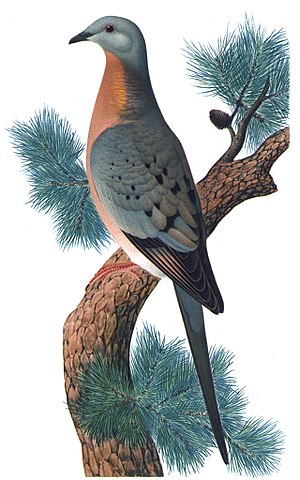Portal:Environment/Selected picture/20

The passenger pigeon was a species of pigeon that was once the most common bird in North America. It is estimated that there were as many as five billion passenger pigeons in the United States at the time Europeans colonized North America. They lived in enormous flocks, and during migration, one could see flocks of them a mile (1.6 km) wide and 300 miles (500 km) long, taking several days to pass and probably containing two billion birds. The species had not been common in the Pre-Columbian period, until the devastation of the American Indian population by European diseases.
Over the 19th century, the species went from being one of the most abundant birds in the world to extinction. At the time, passenger pigeons had one of the largest groups or flocks of any animal, second to only the desert locust.
Some decimation in numbers occurred as a result of loss of habitat, when the Europeans started settling further inland. However, the primary factor emerged when pigeon meat was commercialized as a cheap food for slaves and the poor in the 19th century, resulting in hunting on a massive scale. There was a slow decline in their numbers between about 1800 and 1870, followed by a catastrophic decline between 1870 and 1890, at the end of which they were rare and beyond the point of recovery. 'Martha', thought to be the world's last passenger pigeon, died on September 1, 1914 in Cincinnati.
